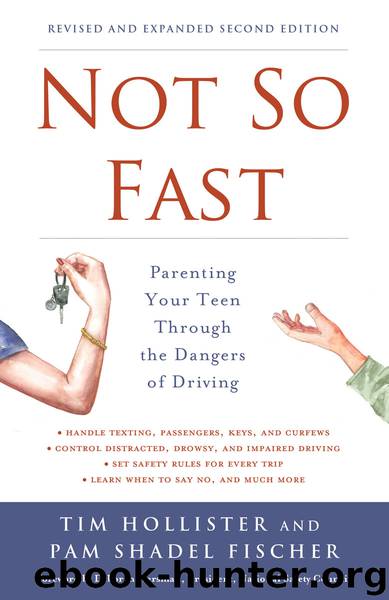Not So Fast by Tim Hollister

Author:Tim Hollister
Language: eng
Format: epub
Publisher: Chicago Review Press
Published: 2018-03-13T04:00:00+00:00
15
Managing Curfews
Teen driver laws in most states set nighttime restrictions or curfews that dictate when teen drivers can and can’t be on the road. In general, the deadline for teen drivers to be off the road ranges from 9:00 PM to midnight. (The most common is 11:00 PM or midnight to 5:00 or 6:00 AM.) Most state laws, however, contain exceptions for employment, school activities, medical needs, religious observances, and participation in volunteer public safety services (fire, ambulance, “safe rides,” and the like), each of which can necessitate driving in the late evening or early morning.
While your state GDL law may include one or more of these exemptions, the exceptions are not based on evidence or less risk. According to the Centers for Disease Control and Prevention, one third of fatal teen crashes occur after dark, with 51 percent happening before midnight. Parents need to determine if a teen is really ready for night driving, and not feel compelled to allow it in a particular situation simply because state law authorizes it.
Here are some thoughts on driving curfews and how to manage them:
Curfews do not address the dangerous one or two hours after school. It is at those times that teens are most likely to be riding with illegal passengers, which substantially increases crash risk. Curfews only target late-night driving, but the hours immediately after school are also a time of elevated crash risk.
As to late-night driving, a constant problem is teen drivers racing home to beat the curfew. In fact, some teens think that getting off the road by the state’s deadline is a legitimate reason to drive at whatever speed is necessary to get home on time.
Curfews do not justify speeding, of course, but they do highlight the importance of planning ahead so that teens will be off the road without speeding. Doing so requires a discussion, before the teen leaves, about the route and the anticipated return trip travel time. Once these are established, parent and teen are better able to plan to comply with the curfew. The departure should also build in a margin for traffic delay; if the route normally takes thirty minutes and the curfew is 11:00 PM, then departure time should be 10:15 PM.
The teen driver should understand that a delay such as a traffic backup that will result in missing the curfew needs to be reported to a parent or guardian as soon as it can be done safely. That means not texting or using a cell phone while driving, but pulling off the road to a safe location at the earliest opportunity to explain the location and extent of the delay. The teen should understand that delays first reported upon arrival at home will be thoroughly questioned.
School events and activities that end after 9:00 PM are a significant problem, because they result in teens driving during the most dangerous hours of the day, often with passengers and when fatigue is likely. Supervising adults should realize that they may need to be chauffeurs even to newly licensed drivers to avoid this dangerous situation.
Download
This site does not store any files on its server. We only index and link to content provided by other sites. Please contact the content providers to delete copyright contents if any and email us, we'll remove relevant links or contents immediately.
The Lost Art of Listening by Michael P. Nichols(7356)
Rich Dad Poor Dad by Robert T. Kiyosaki(6313)
We Need to Talk by Celeste Headlee(5493)
I Love You But I Don't Trust You by Mira Kirshenbaum(3773)
The Complete Idiot's Guide to Coping With Difficult People by Arlene Uhl(3093)
Rich Dad Poor Dad: What The Rich Teach Their Kids About Money - That The Poor And Middle Class Do Not! by Robert T. Kiyosaki(2874)
The Book You Wish Your Parents Had Read (and Your Children Will Be Glad That You Did) by Philippa Perry(2415)
A Burst of Light by Audre Lorde(2402)
Life Hacks by Dan Marshall(2388)
Dealing with People You Can't Stand by Dr. Rick Brinkman(2301)
An Odyssey by Daniel Mendelsohn(2236)
The Expectant Father by Armin A. Brott & Jennifer Ash(2191)
Teach Your Child How to Think by Edward De Bono(2106)
No Time to Say Goodbye(2022)
The Out-of-Sync Child by Carol Stock Kranowitz(2001)
What I Need by J. Daniels(1992)
The 7 Habits Of Highly Effective Teens by Covey Sean(1965)
I Don't Belong to You by Keke Palmer(1934)
The Self-Driven Child by William Stixrud PhD & Ned Johnson(1900)
